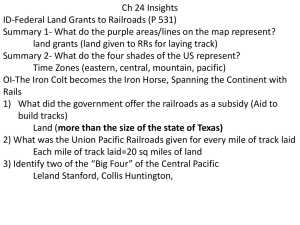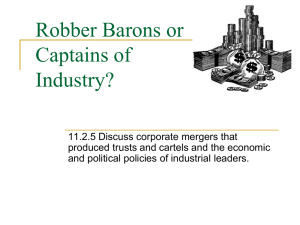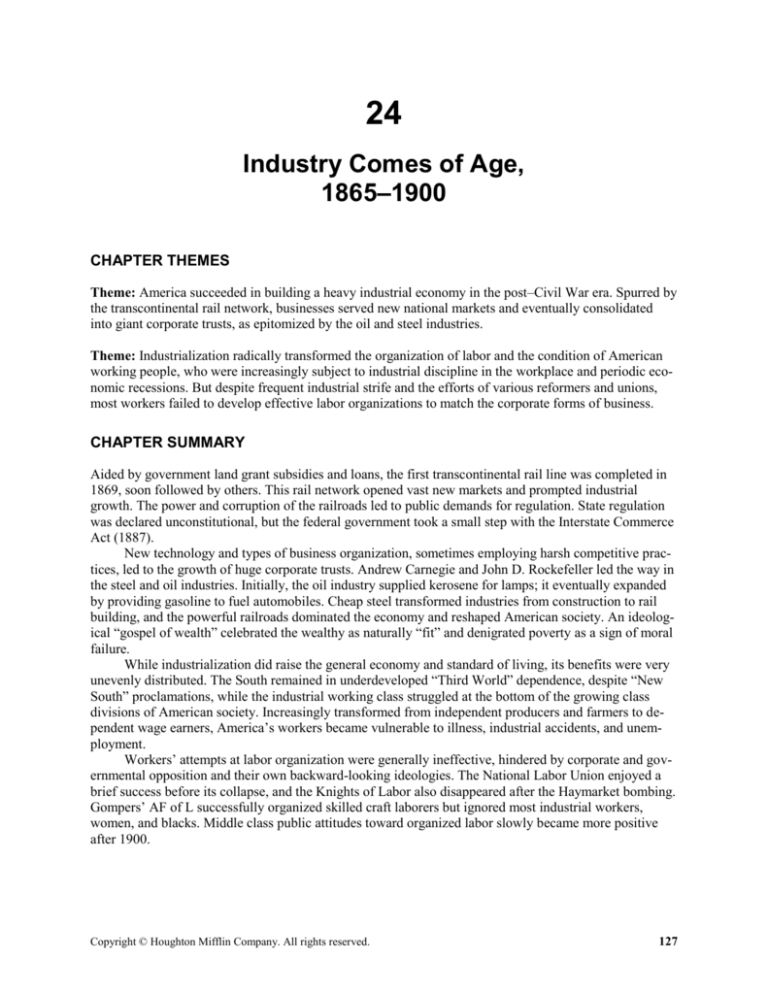
24
Industry Comes of Age,
1865–1900
CHAPTER THEMES
Theme: America succeeded in building a heavy industrial economy in the post–Civil War era. Spurred by
the transcontinental rail network, businesses served new national markets and eventually consolidated
into giant corporate trusts, as epitomized by the oil and steel industries.
Theme: Industrialization radically transformed the organization of labor and the condition of American
working people, who were increasingly subject to industrial discipline in the workplace and periodic economic recessions. But despite frequent industrial strife and the efforts of various reformers and unions,
most workers failed to develop effective labor organizations to match the corporate forms of business.
CHAPTER SUMMARY
Aided by government land grant subsidies and loans, the first transcontinental rail line was completed in
1869, soon followed by others. This rail network opened vast new markets and prompted industrial
growth. The power and corruption of the railroads led to public demands for regulation. State regulation
was declared unconstitutional, but the federal government took a small step with the Interstate Commerce
Act (1887).
New technology and types of business organization, sometimes employing harsh competitive practices, led to the growth of huge corporate trusts. Andrew Carnegie and John D. Rockefeller led the way in
the steel and oil industries. Initially, the oil industry supplied kerosene for lamps; it eventually expanded
by providing gasoline to fuel automobiles. Cheap steel transformed industries from construction to rail
building, and the powerful railroads dominated the economy and reshaped American society. An ideological “gospel of wealth” celebrated the wealthy as naturally “fit” and denigrated poverty as a sign of moral
failure.
While industrialization did raise the general economy and standard of living, its benefits were very
unevenly distributed. The South remained in underdeveloped “Third World” dependence, despite “New
South” proclamations, while the industrial working class struggled at the bottom of the growing class
divisions of American society. Increasingly transformed from independent producers and farmers to dependent wage earners, America’s workers became vulnerable to illness, industrial accidents, and unemployment.
Workers’ attempts at labor organization were generally ineffective, hindered by corporate and governmental opposition and their own backward-looking ideologies. The National Labor Union enjoyed a
brief success before its collapse, and the Knights of Labor also disappeared after the Haymarket bombing.
Gompers’ AF of L successfully organized skilled craft laborers but ignored most industrial workers,
women, and blacks. Middle class public attitudes toward organized labor slowly became more positive
after 1900.
Copyright © Houghton Mifflin Company. All rights reserved.
127
128
Chapter 24
DEVELOPING THE CHAPTER: SUGGESTED LECTURE OR DISCUSSION TOPICS
Explain the central role the railroads played in late-nineteenth-century America. Show how they not
only moved goods and people but also dominated politics, employed workers, promoted farms and
cities, and created the models for American big business. Perhaps use the building of the transcontinental railroad as a key symbolic event of the age.
REFERENCE:
David Bain, Empire Express: Building the First Transcontinental Railroad (1999).
Examine the dramatic impact of “big business” and the new industrial corporations on the American economy and American life generally. Use Andrew Carnegie and John D. Rockefeller as examples of how the new corporate industrial organizers became widely celebrated heroes as well.
Consider their effects not only on the economy but also on American culture.
REFERENCE:
Alan Trachtenberg, The Incorporation of America: Culture and Society in the Gilded
Age (1982).
Consider the impact of industrialization on the nature of work and the lives of workers. Point out
how most workers went from being self-employed or working in small enterprises to being employed in large, impersonal corporate enterprises.
REFERENCE:
Herbert Gutman, Power and Culture: Essays on the American Working Class (1987).
Analyze the growing place of wage-earning women in the late-nineteenth-century industrial economy. Compare and contrast men’s and women’s attitudes toward work, family, and labor unions.
REFERENCE:
Alice Kessler-Harris, Out to Work: A History of Wage-Earning Women in the United
States (1982).
FOR FURTHER INTEREST: ADDITIONAL CLASS TOPICS
Discuss the railroads as both romantic enterprise (for example, the golden spike, the luxurious
Pullman cars) and as controversial “exploitative” business (for example, the corruption of legislatures, price-fixing).
Examine the benefits and drawbacks of industrialization for various groups (business, labor, women, minorities, immigrants).
Using Edison as a symbol of the emerging technological and industrial age, show how his inventions were quickly taken up and incorporated into huge new industries.
Use the Haymarket affair to illustrate the growing class conflicts in industrial America and to highlight the debates over how American workers should respond to the new industrial conditions.
Copyright © Houghton Mifflin Company. All rights reserved.
Industry Comes of Age, 1865–1900
129
CHARACTER SKETCHES
Thomas Edison (1847–1931)
Edison was the inventive genius of American industrialization who symbolized the modern fusion of science, technology, and industry.
Edison was regarded as a very slow student, and consequently his formal education lasted only
three months. Still a boy, he turned to selling newspapers on the streets of Port Huron, Michigan, handing
over some of the money to his family but spending the rest on books and chemicals. At age fifteen he
went to work for the telegraph. His first inventions were electrical stock tickers and vote recorders.
He took out over a thousand patents in his life. Among his lesser-known inventions were synthetic
chemicals, waxed paper, Portland cement, the mimeograph machine, and light sockets and fixtures.
Although celebrated as a solitary genius, Edison actually developed the new forms of team research
and systematic technological innovation. His laboratory at Menlo Park, New Jersey, was set up in 1880
and employed teams of researchers financed by industry.
Quote: “The first step is an intuition—and comes with a burst, then difficulties arise.… ‘Bugs,’ as such
little faults and difficulties are called—show themselves, and months of anxious watching, study, and labor are requisite.…I have the right principle and am on the right track, but time, hard work, and some
good luck are necessary, too.…” (Letter, 1878)
REFERENCE:
Paul Israel, Edison: A Life of Invention (1998).
Andrew Carnegie (1835–1919)
Carnegie was a Scottish immigrant who became the leading industrialist of the American steel industry
and a prominent philanthropist.
His parents, Scottish hand-loom weavers, were well informed and very interested in education. The
family came to the United States when Carnegie’s father was thrown out of work by the new textile mills.
Carnegie’s boyhood dream was to dress his mother in silks, and she lived long enough for him to shower
her with expensive gifts.
Carnegie decided early in his career that he should eventually give away most of his money. He
spent much of his time associating with literary people and writing magazine articles and books. Eventually, he gave away an estimated $350 million, including $60 million to American libraries.
Charming, smooth, and polished, Carnegie was generally popular with the public.
Quote: “Thirty-three, and an income of $50,000 per annum.…Beyond this never earn—make no effort to
increase fortune, but spend the surplus each year for benevolent purposes.…” (Memo to himself, 1868)
REFERENCE: Joseph
Frazier Wall, Andrew Carnegie (1970).
John D. Rockefeller (1839–1937)
Rockefeller was the industrialist who organized the Standard Oil Company and became the leading symbol of American capitalism.
His mother was harsh, austere, and religious, and Rockefeller inherited these qualities from her. He
was generally frugal and humorless. As a young man, he taught Sunday school and always remained a
committed member of the Baptist church.
Copyright © Houghton Mifflin Company. All rights reserved.
130
Chapter 24
Rockefeller avoided serving in the Civil War to devote himself to business. He began his career by
working with a Cleveland merchant and bought his first refinery for $72,000.
He retired from active control of Standard Oil in 1897. By the 1920s his net worth was probably a
billion dollars.
Quote: “In speaking of the real beginnings of the Standard Oil Company, it should be remembered that it
was not so much the consolidation of the firms in which we had a personal interest, but the coming together of the men who had the combined brainpower to do the work.…It is not merely capital and plans
and the strictly material things that make up a business, but the character of the men behind these
things.…” (1909)
REFERENCE:
Ron Chernow, Titan: The Life of John D. Rockefeller, Sr. (1998).
Samuel Gompers (1850–1924)
Gompers was the American labor leader who organized the American Federation of Labor and promoted
the strategy of conservative craft organization.
Almost entirely self-educated, Gompers gained much of his knowledge by reading and attending
lectures in New York City. He was very well acquainted with European socialist thinkers and even
learned German so he could read Karl Marx in the original. But he always believed the Marxists and socialists were wrong and worked to develop arguments against them.
Gompers loved drama and pageantry but kept the “secret brotherhood” approach out of the AF of L
unions. He disliked reformers and intellectuals, calling them “industrially impossible.” Although strongly
patriotic, after World War I Gompers and the AF of L were often accused of being “un-American” for
promoting labor organization and strikes.
Quote: “The trusts are our employers, and the employer who is fair to us, whether an individual or a collection of individuals in the form of a corporation or a trust, matters little to us as long as we obtain fair
wages.” (1912)
REFERENCES:
Harold Livesay, Samuel Gompers and Organized Labor in America (1987); David Montgomery, The Fall of the House of Labor (1987).
QUESTIONS FOR CLASS DISCUSSION
1. What were the costs and benefits of the industrial transformation of the post-Civil War era?
2. Should industrialists like Vanderbilt, Carnegie, and Rockefeller be viewed as “robber barons” or
“captains of industry”?
3. Was the growing class division of the time a threat to American democracy? Why or why not?
4. Why did American workers have such trouble responding to the new industrial conditions of labor?
Why were business and the middle-class public generally hostile to allowing workers to organize as
industry did? Why did the AF of L survive while the Knights of Labor failed?
Copyright © Houghton Mifflin Company. All rights reserved.
Industry Comes of Age, 1865–1900
131
MAKERS OF AMERICA: THE KNIGHTS OF LABOR
Questions for Class Discussion
1. What was admirable and “progressive” in the Knights’ outlook? What was largely nostalgic and
doomed to failure?
2. What was the appeal of the Knights’ emphasis on secrecy, ritual, and “brotherhood”? What elements
of the Knights’ emphasis on social solidarity remained part of the labor movement, and what disappeared?
Suggested Student Exercises
Examine the Knights’ role in the great industrial strikes of 1886. Explain why they experienced a
boom in membership, especially with the advocacy of the eight-hour day, and then suddenly collapsed and soon disappeared.
Examine the biographies of the Knights’ two most prominent leaders, Terence Powderly and
“Mother” Jones. Perhaps compare their “utopian” and “producer”-oriented outlook with that of
more pragmatic unionists like Samuel Gompers and socialists like Eugene V. Debs.
EXPANDING THE “VARYING VIEWPOINTS”
Matthew Josephson, The Robber Barons: The Great American Capitalists, 1861–1901 (1934).
A view of industrialization focused on business:
“The members of this new ruling class were generally, and quite aptly, called ‘barons,’ ‘kings,’
‘empire-builders,’ and even ‘emperors.’ They were aggressive men, as were the first feudal barons;
sometimes they were lawless; in important crises, nearly all of them tended to act without those established moral principles which fixed more or less the conduct of the common people of the community. At the same time…many of them showed volcanic energy and qualities of courage which,
under another economic clime, might have fitted them for immensely useful social constructions,
and rendered them glorious rather than hateful to their people.”
Herbert Gutman, Work, Culture, and Society in Industrializing America (1976).
A view of industrialization focused on labor and society:
“In the half-century after 1843 industrial development radically transformed the earlier American
social structure, and during this Middle Period…a profound tension existed between the older
American preindustrial social structure and the modernizing institutions that accompanied the development of industrial capitalism.…In each of these distinctive stages of American society, a recurrent tension also existed between native and immigrant men and women fresh to the factory and
the demands imposed upon them by the regularities and disciplines of factory labor.”
Copyright © Houghton Mifflin Company. All rights reserved.
132
Chapter 24
QUESTIONS ABOUT THE “VARYING VIEWPOINTS”
1. What does each of these historians see as the most crucial feature of the new industrialization?
2. How does each of them see the relationship between industrial capitalism and the moral and cultural
values of society?
3. How would each of them likely interpret the labor conflicts and strikes of the period—for example,
the Haymarket affair and the decline of the Knights of Labor?
Copyright © Houghton Mifflin Company. All rights reserved.


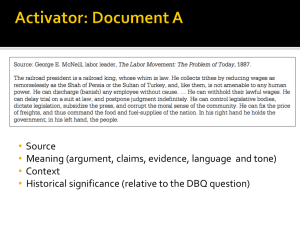
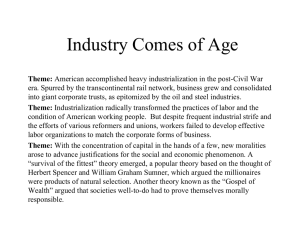

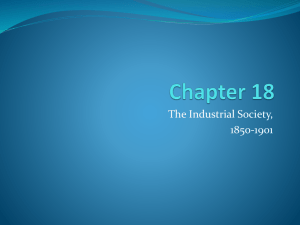

![men_who_built_america[1]](http://s2.studylib.net/store/data/005219845_1-7979604da89ac700f7913bb56611cc41-300x300.png)
